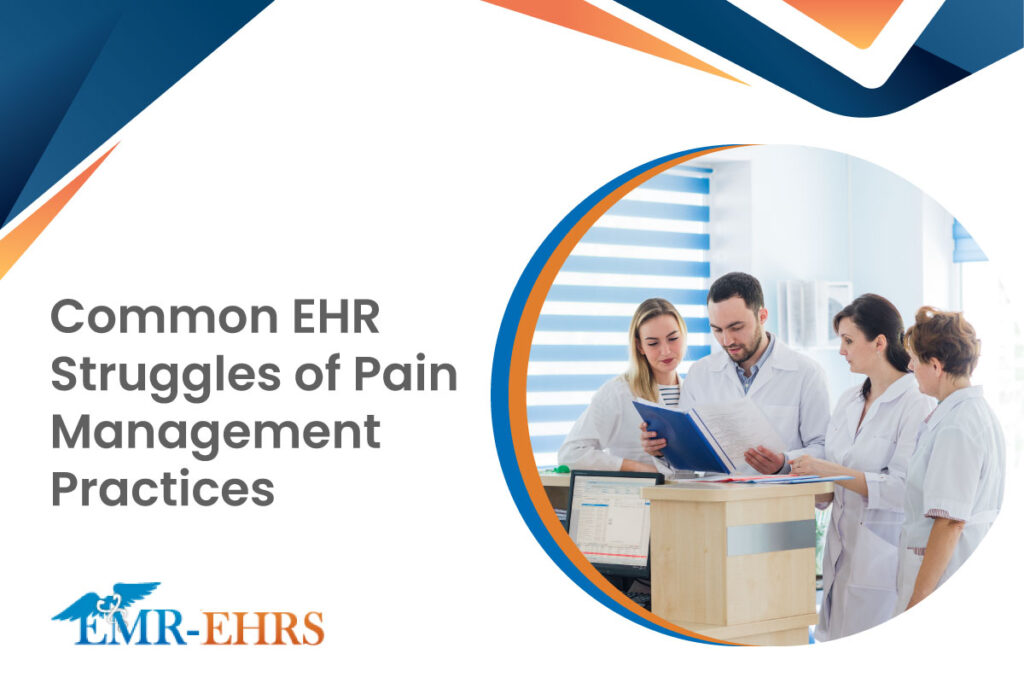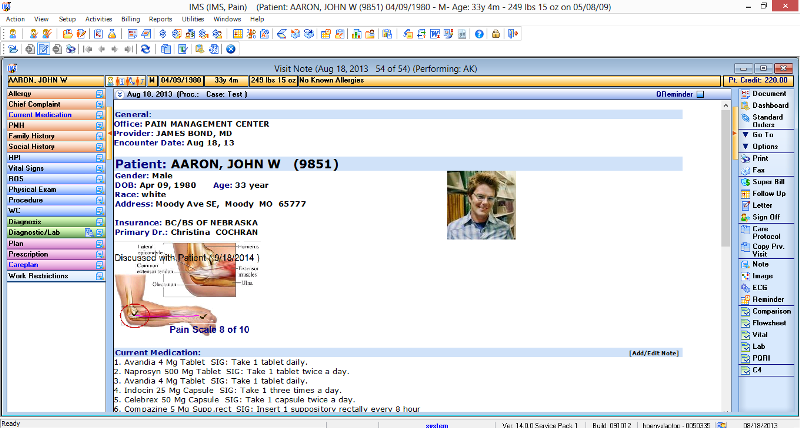
Over the last decade, the medical industry has undergone numerous changes. Likewise, physicians know that keeping up with the advancements of the electronic era in health care requires sophisticated technology. Among the systems that have steadily improved over time is the Electronic Health Record (EHR).
An EHR is necessary to effectively run and keep accurate health records to offer comprehensive and timely care when it comes to pain management practices. This improved care involves using and exchanging health data among or within healthcare institutions mandated by the federal government. However, there will always be common EHR systems with challenges, such as the implementation process.
The purpose of this article is to discuss the most common pain medicine EHR struggles of pain management practices that providers encounter as well as solutions to those problems.
5 Most Common EHR Struggles of Pain Management Practices
- The Cost of Implementation
When purchasing a pain management EHR it is important to do your research and find an EHR provider that will help you along your EHR implementation journey and find the best practice management software for your pain clinic. The last thing you want to do is spend money on an EHR and the additional cost of time trying to figure out how to use it.
A recent study estimated that providers spend a significant amount of money not only on purchasing electronic health records (EHRs) but on additional services and implementation. It is not surprising that electronic health records are expensive, though it is critical to have a team that offers support during this translation and makes the cost justifiable.
On the other hand, the optimization, selection, and implementation of EHRs will consume the most capital budget expenditure.
Practice management software installation for EHRs consists of five steps:
- Hardware setup
- Software purchase
- Implementation support
- Staff training
- Ongoing network fees.
However, unexpected costs may occur during implementation In particular, for smaller practices and organizations, financing is one of the significant barriers to installing an EHR.
- Privacy and Security of Patient Information
Pain management practices are not the only ones concerned about keeping patient data secure in their EHRs. In a 2018 report by HIPAA Journal, data breaches affecting 500 or more healthcare records occurred on average once per day.
Data breaches in healthcare are notorious for inflicting hefty penalties on organizations and individuals who commit them. A security breach might also result in legal action against the company and millions of dollars in compensation.
Therefore, healthcare providers must educate themselves on how to mitigate cybersecurity risks and protect patient information before integrating an EHR system.
- Miscommunication
There are now over 99% of practices using certified EHRs for important clinical decisions. In pain management practices, this new technology must support effective communication.
On the other hand, one of the most common EHR practice management software problems is internal miscommunication. For example, clinical communication failures result from clinicians not communicating important information about a patient’s symptoms or condition or failing to document it properly.
Thus, the inability to assess the severity of a patient’s condition can result in incorrect treatment decisions and delays in treatment.
- Data Interoperability
Efficiently providing care relies on sharing clinical data within the organization and with other providers. However, healthcare providers still struggle to share data despite government incentives and regulations. EHRs are particularly prone to this.
A recent study revealed that close to 32% of patients who visited their doctors in the 12 months prior to the research reported a visible gap in information exchange.
Thus, interoperability issues cause healthcare providers problems with practice management and can negatively impact patient satisfaction.
- Training
Training employees thoroughly on the new process before deploying the pain management EHR system is essential. Medical staff must devote significant time and effort to learning the new format. Neither staff nor management enjoys this time-consuming and inconvenient process.
The most common concern among low- and medium-sized businesses during the training stage is losing business.
Essential EHR Solutions for Pain Management Practices
- Managing Inpatient Discomfort With Pain Assessments.
The use of assessments can help healthcare providers better understand a patient’s pain tolerance. When we document the patient’s pain scale in the pain medicine EHR and learn about effective measures they’ve used to manage pain, it’s easier to teach them when narcotics should be prescribed instead of acetaminophen or ibuprofen. The pain management EHR also allows providers to automatically schedule reassessments after administering pain medication to monitor its effectiveness.
- Provide Education to Patients Across All Settings of Care.
Several physician practices are hiring case managers to educate patients about safe pain management options and the dangers of overusing and misusing opioids. Narcotic withdrawal counseling should be provided to all surgical and inpatient patients. In addition, it has been shown that integrating this information in discharge instructions improves outcomes compared with generic, canned answers such as “Take prescribed medication to keep your pain level under control.”
- Determine the Most Effective Methods of Pain Management.
Clinical decision support strategies using pharmacogenomics enable clinicians to provide pain relief tailored to each patient’s unique needs, resulting in a quicker recovery and reduced reliance on narcotics. For instance, DNA mapping can help determine which pain medications are most appropriate for a patient post-surgery. It can also alert providers if a pain medication selected for a patient is deemed ineffective based on their DNA profile.
Get the best EHR for your Pain Management Practice.
Once you implement and use a new electronic health records system, your pain management practice will become more streamlined and efficient. Prepare for possible pitfalls when your employees use your new pain management EHR.
Choose the Top EMR/EHR Software
Over the years, we have assisted medical practices with physical medicine EMR/EHR selection, implementation, and software usage. We specialize in providing customized EMR/EHR practice management software to meet your practice’s specific needs.
Schedule a demo or contact us through the contact form for more personalized information. Let’s work together to find the best software for your practice!
Do you have a favorite EHR add-on service? You are free to comment below!





 The American Academy of Pain Medicine (AAPM) is holding their 30th annual Pain Medicine conference this March, titled the Emerging Science & Research of Pain Medicine – and 1st Providers Choice is proud to announce that our
The American Academy of Pain Medicine (AAPM) is holding their 30th annual Pain Medicine conference this March, titled the Emerging Science & Research of Pain Medicine – and 1st Providers Choice is proud to announce that our 

